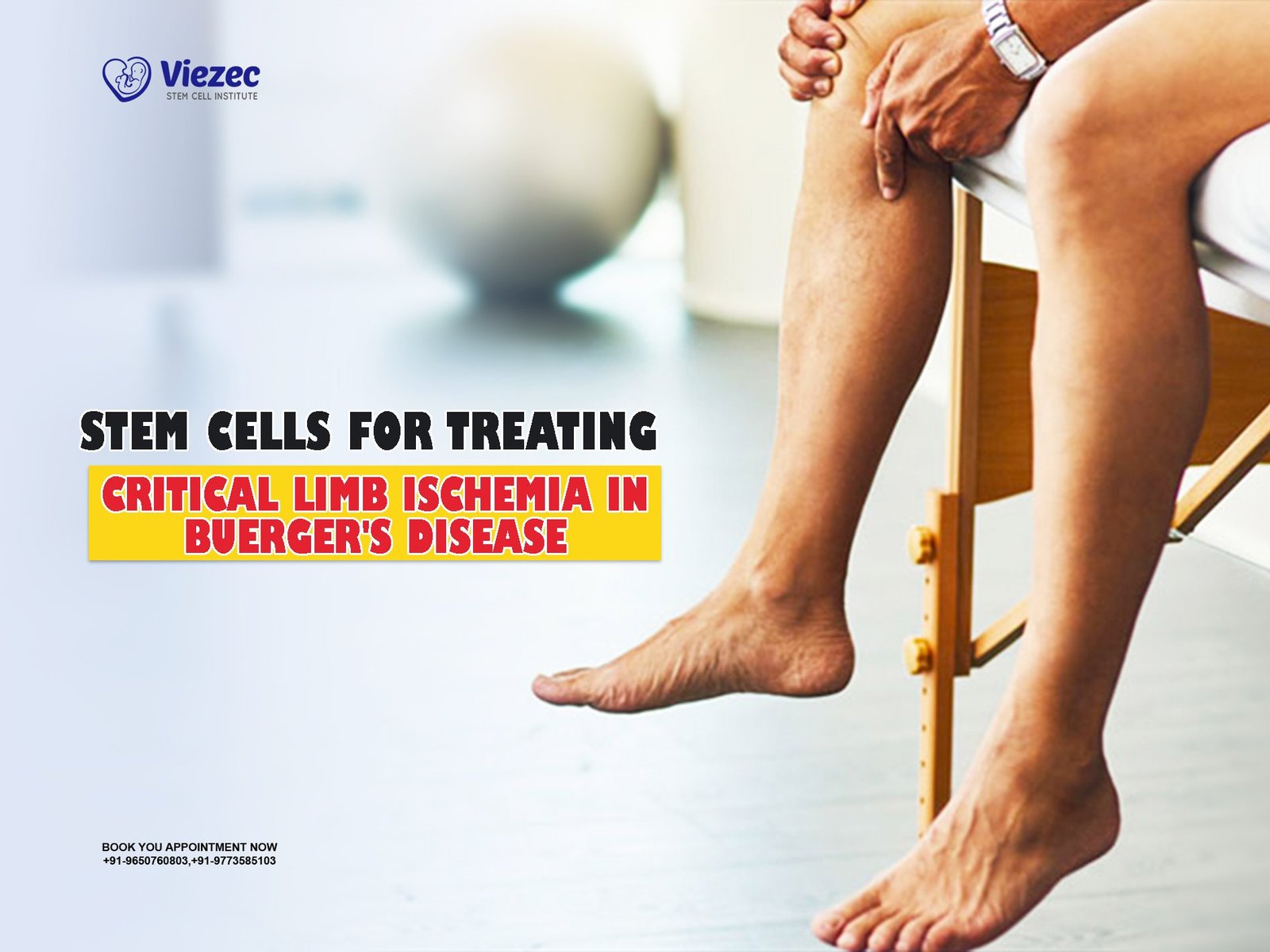In the intricate realm of vascular disorders, Buerger’s Disease stands as a formidable challenge, particularly when complicated by Critical Limb Ischemia (CLI). This condition, marked by severe obstruction of arteries, demands innovative solutions. Amidst the evolving landscape of medical research, the potential of stem cells emerges as a beacon of hope in managing CLI within the context of Buerger’s Disease. Stem cells, with their regenerative prowess, hold promise in addressing the unique challenges posed by this ailment. This introduction delves into the pivotal role of stem cells, exploring their potential to revolutionize treatment approaches and offer newfound optimism for those grappling with the complexities of Buerger’s Disease and its vascular ramifications.
Understanding Buerger’s Disease
Buerger’s Disease is a rare autoimmune disorder that primarily affects the arteries and veins of the extremities, causing reduced blood flow. Smoking is a major risk factor, and the disease predominantly affects young to middle-aged individuals. The link between smoking and the development of Buerger’s Disease is a critical aspect of understanding the condition.
Challenges in Managing Critical Limb Ischemia
Managing Critical Limb Ischemia (CLI) presents a formidable medical challenge, particularly when intertwined with conditions like Buerger’s Disease. CLI, characterized by severely compromised blood flow to the extremities, poses unique hurdles in its treatment. In the context of Buerger’s Disease, an autoimmune disorder exacerbated by smoking, the challenges intensify. Traditional approaches confront the inflammatory nature of the disease, making the search for innovative solutions imperative. This article delves into the complexities of managing CLI, exploring the distinctive obstacles posed by Buerger’s Disease and shedding light on the potential role of stem cells as a promising avenue for effective intervention.
Role of Stem Cells
The role of stem cells in medical science is transformative, offering unprecedented potential for regenerative therapies. Stem cells possess unique capabilities to differentiate into specialized cells, contributing to tissue repair and regeneration. In the context of managing Critical Limb Ischemia in Buerger’s Disease, stem cells exhibit a promising role in stimulating the formation of new blood vessels and addressing specific challenges associated with impaired circulation. Whether derived from the patient or other sources, these versatile cells hold the key to innovative treatments. Ongoing research and clinical trials continue to unveil the remarkable and multifaceted role of stem cells in reshaping the landscape of medical interventions.
Mechanism of Action
The mechanism of action underlying stem cell therapy for Critical Limb Ischemia (CLI) in Buerger’s Disease is intricate yet promising. Stem cells, introduced into the affected area, exhibit remarkable regenerative abilities. They differentiate into specialized cells, fostering the formation of new blood vessels and facilitating tissue repair. This reparative process addresses the ischemic challenges unique to Buerger’s Disease. By promoting angiogenesis and alleviating vascular obstructions, stem cells hold the potential to rejuvenate blood flow, offering a novel approach to managing CLI. Understanding this mechanism is pivotal for unlocking the therapeutic benefits and advancing treatment options for individuals grappling with this complex vascular condition.
Clinical Trials and Research Findings
Clinical trials investigating stem cell therapy for Critical Limb Ischemia (CLI) in Buerger’s Disease have yielded promising research findings. These trials assess the safety and efficacy of stem cell treatments, showcasing positive outcomes in terms of improved blood flow and tissue repair. The encouraging results from ongoing research contribute to the growing body of evidence supporting the potential of stem cells as a viable option for managing CLI in individuals affected by Buerger’s Disease.
Benefits and Risks of Stem Cell Therapy
Stem cell therapy presents a revolutionary approach to treating various medical conditions, including Critical Limb Ischemia in Buerger’s Disease. The significant benefit lies in its regenerative potential, promoting tissue repair and blood vessel formation. However, potential risks, such as tumorigenicity and immunogenicity, must be considered. Careful evaluation and monitoring are crucial to ensure the safety and efficacy of stem cell therapy, making it imperative for patients and healthcare professionals to weigh both the potential benefits and associated risks.
Patient Experiences
Real-life cases of individuals undergoing stem cell therapy for CLI in Buerger’s Disease provide valuable insights. Success stories and challenges faced by patients offer a more personalized perspective on the impact of stem cell treatments.
Comparisons with Traditional Treatments
Comparing stem cell therapy with traditional treatments for CLI, such as medications and surgical interventions, helps evaluate the effectiveness and long-term outcomes of each approach. Understanding the advantages and limitations of both options is essential for informed decision-making.
Future Prospects
As research in stem cell therapy continues to advance, the future holds promising prospects for managing CLI in Buerger’s Disease. Emerging technologies and innovative approaches are likely to enhance treatment options and outcomes for patients.
Recommendations for Patients
Identifying which patients are most likely to benefit from stem cell therapy and considering individual health factors is crucial. Patients and healthcare providers should collaborate to make informed decisions about the suitability of stem cell treatments for managing CLI in Buerger’s Disease.
Expert Opinions and Perspectives
Gaining insights from healthcare professionals involved in stem cell research and treatment provides a well-rounded view of the current landscape. Expert opinions and perspectives contribute to a comprehensive understanding of the potential of stem cells in managing CLI in Buerger’s Disease.
In conclusion, the potential of stem cells in managing Critical Limb Ischemia in Buerger’s Disease is a promising avenue. With ongoing research, positive clinical outcomes, and the regenerative capabilities of stem cells, there is hope for improved treatment options for individuals facing this challenging condition.
FAQs
- Is stem cell therapy the only treatment option for Critical Limb Ischemia in Buerger’s Disease?
- No, there are various treatment options available, including medications and surgical interventions. Stem cell therapy is a promising alternative under investigation.
- Are there any side effects associated with stem cell therapy for CLI in Buerger’s Disease?
- While stem cell therapy shows potential benefits, it’s crucial to consider potential risks such as tumorigenicity and immunogenicity. Consultation with healthcare professionals is essential.
- How can patients determine if they are suitable candidates for stem cell therapy?
- Individual health factors, severity of the condition, and consultation with healthcare providers play a significant role in determining the suitability of stem cell therapy for CLI in Buerger’s Disease.
- What is the cost of stem cell therapy for Critical Limb Ischemia?
- The cost of stem cell therapy can vary. It’s essential to consider individual financial factors and inquire about costs and potential financial assistance options.
- Are there any ongoing clinical trials for stem cell therapy in Buerger’s Disease?
- Yes, there are ongoing clinical trials exploring the efficacy and safety of stem cell therapy for managing CLI in Buerger’s Disease. Stay updated on the latest research findings.









